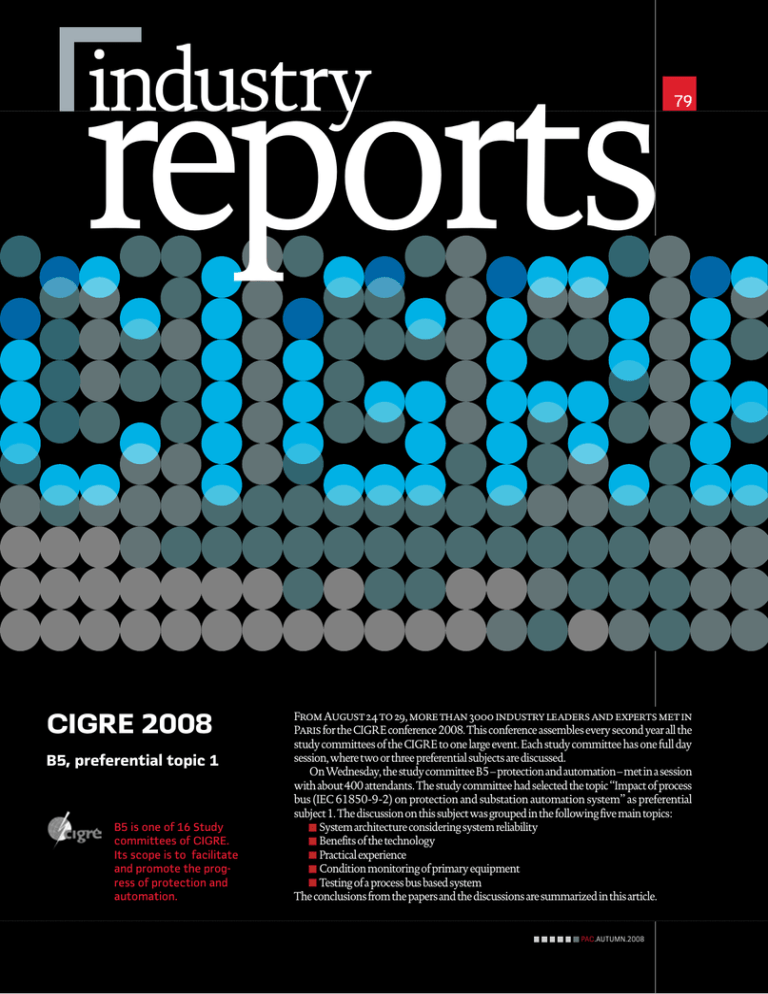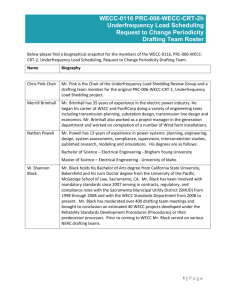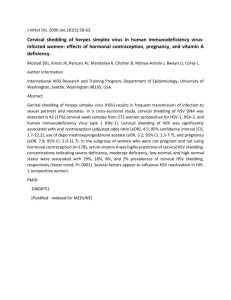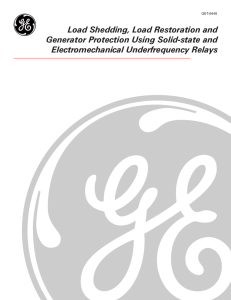reports industry CIGRE 2008 79
advertisement

reports industry CIGRE 2008 B5, preferential topic 1 B5 is one of 16 Study committees of CIGRE. Its scope is to facilitate and promote the progress of protection and automation. 79 From August 24 to 29, more than 3000 industry leaders and experts met in Paris for the CIGRE conference 2008. This conference assembles every second year all the study committees of the CIGRE to one large event. Each study committee has one full day session, where two or three preferential subjects are discussed. On Wednesday, the study committee B5 – protection and automation – met in a session with about 400 attendants. The study committee had selected the topic “Impact of process bus (IEC 61850-9-2) on protection and substation automation system” as preferential subject 1. The discussion on this subject was grouped in the following five main topics: System architecture considering system reliability Benefits of the technology Practical experience Condition monitoring of primary equipment Testing of a process bus based system The conclusions from the papers and the discussions are summarized in this article. PAC.AUTUMN.2008 by Christoph Brunner, Switzerland CIGRE B5 industry reports 80 The architecture of a substation automation system may significantly be changed, when a process bus based on IEC 61850 is added. Issues to be considered include testing, reliability and time synchronization. To achieve a cost reduction is one of the major drivers to introduce a process bus. A fully distributed system may offer the most flexibility. However, to address concerns on reliability and availability, optimized system architectures are proposed. This is a controversial topic. Some consider an optimization to address the availability issues as needed and not providing limitations. That may be restricted to the grouping of functions, but not necessarily to the communication links. Other contributions state that by using real time Ethernet, the availability issues can be solved using a flexible architecture. Availability figures were presented for different architectures. From the selected architectures, all redundant solutions fulfill the requirements. There was an agreement, that an interoperable solution for time synchronization is required as part of the standard. Currently, this is a 1 PPS signal; however, other solutions like IEEE 1588 are proposed as part of a new edition of the standard. Several aspects of time synchronization that need to be considered where mentioned. Samples need to be synchronized at source and the standardization of sample rate is important for interoperability. Synchronization islands may improve availability. Cyber security for a process bus was not discussed in the papers, but the issue was raised in the discussion during the conference. All contributors agreed about the relevance, but had different opinions on the methods to be used. One proposal was, to use physical security methods; i.e. to build a fence around the substation and keep it simple inside. Another proposal was to avoid security issues by choosing a point to point architecture. The third proposal referred to SW methods based on IEC 62351, but it was not recommended to use cryptography for GOOSE and sampled value messages. When introducing a new technology within a system, it is not sufficient to consider only the technical factors. Business benefits like the overall installation costs versus payback are another factor. The process bus helps to do more projects faster, with less resources and less costs. During the session, the key features that reduce the life cycle costs of a process bus based substation automation system have been discussed. These features include an easier implementation, the elimination of copper wires and 1 Optimizing system architecture MU Controler QA11 BZ51 QA11 Line Protection Controler QA31 MU BZ12 QA31 MU BZ22 MU BZ22 QA21 PAC.AUTUMN.2008 CIGRE meetings are based on a "Special Reporter" system. the self-describing documentation. Extensions and upgrades of the system can be done as SW modifications and the maintenance on the system can be done safely. Another important aspect is the possibility to easily integrate non conventional CTs and VTs with lower costs compared to conventional devices. Based on the experience with projects using a process bus, there is an agreement, that conformance testing is not sufficient to guarantee interoperability. The experience with interoperability of devices from multiple vendors is various. The freedom offered by the standard in several areas can result in lacking interoperability between IEDs and requires flexibility from client applications. There is still some hesitation concerning the market acceptance of IEC 61850. A simple architecture, scalability and testability are important for an acceptance. The use of the process bus may be first accepted for new stations or extension of stations with new bays rather than for retrofit projects. In migration scenarios, mixed mode may be required, which means that a relay has to deal at the same time with digital signals from a new sensor system and analog signals from an old sensor system. Experience with mixed mode is available from pilot projects. A different solution to designing protection relays with both analog as well as digital inputs can be to add instead merging units to the old sensor system doing the analog to digital conversion outside the relay. Condition monitoring of primary equipment is done in order to either extend the life of the equipment or to change from a time based maintenance to a condition based maintenance. New logical nodes will be defined in edition 2 of IEC 61850 to model the condition monitoring information. IEC 61850 in general will have an impact on testing. Standardized configuration files can be used to configure test equipment. With the introduction of a process bus new concepts are required in particular concerning the isolation of the device under test from the rest of the system. The standard offers several features that can help, but specifications on how to use and interpret these features are required to achieve interoperability. The protection relay, the communication network including communication links and the merging unit and primary equipment are three components that need to be tested independently. Using the substation configuration language, an automation of the tests is possible. To conclude, we can note that significant progress has been made since the publication of IEC 61850. Different approaches of system architectures exist that address the availability of process bus based solutions. There are some concerns about the impact of Ethernet switches on the availability of the system. Some further standardization work is required to facilitate the use of the process bus. Introduction of a time synchronization method that uses the communication network may help to reduce costs and improve availability. The use of the different features for testing support provided by IEC 61850 may need further agreements to achieve interoperability. In general, it may be appropriate to have more agreements that limit some of the flexibility of IEC 61850 for the benefit of easier integration of multi vendor systems. Nevertheless, the technology has been proven, the solutions exist and the experience is available to successfully implement process bus in real projects. IEEE Guide for Underfrequency Load-shedding and Restoration IEEE C37.117 is a Guide for the application of protective relays used for load shedding and restoration during electric power system abnormal frequency conditions. It presents background information, bibliography, and recommendations. It discusses abnormal frequency power system behavior, existing load shedding and restoration practices, the abnormal frequency function of typical protective relays, and possible new methods for improved load shedding and restoration. This Guide is limited to electric power system applications and does not include Abnormal Frequency Protection for Power Generating Plants. It was developed because at the time there was no IEEE Guide for the application of protective relays used for load shedding and restoration during electric power system abnormal frequency conditions. This Guide complements the IEEE Guide for Abnormal Frequency Protection of Power Generating Plants. It provides information to assist in the application of load shedding and restoration schemes. Methods and examples are provided. The material is presented in fifteen parts and one appendix. System Conditions The predominant system condition addressed by IEEE C37.117 The Power System Relaying Committee is in the Power & Energy Society of IEEE. involves the use of protective relays for underfrequency shedding of connected load in the event of insufficient generation or transmission capacity within a power system. It is performed in order to minimize the risk of a further uncontrolled system separation, loss of generation, or system shutdown. If sufficient load is shed to preserve interconnections and keep generators on line, the system can be restored rapidly. If the system collapses, a prolonged outage will result. Fig 1 Underfrequency load shedding plans are based on studies of a system’s dynamic performance, given the greatest probable imbalance between load and generation. Underfrequency relaying can also be utilized to sense disturbances and separate power systems by opening system ties, as well as to separate non-utility generation from the utility power system. Plans should be coordinated between interconnected power systems as well as with underfrequency isolation of generating units, tripping of shunt capacitors, and other automatic actions which occur in the system under abnormal PAC.AUTUMN.2008 by Alexander Apostolov, OMICRON electronics, USA IEEE PES PSRC industry reports 82 frequency, voltage, or power flow conditions. After an underfrequency load shedding event, frequency relays can be utilized to automatically restore or supervise the restoration of load to a power system. Sufficient time delay should be employed to assure that the power system is stable prior to initiating load restoration. In areas where isolation of a large surplus of generation relative to connected load can be anticipated, automatic overfrequency tripping of generation may be considered to prevent excessive high frequency and resultant uncontrolled generator tripping and equipment damage. Underfrequency load shedding and restoration philosophies are applied to restore the system frequency to an acceptable level following a major system emergency that can cause a generation deficiency and prevent a total system collapse, as well as help achieve fast restoration of all affected loads. Underfrequency load shedding must be performed quickly to arrest power system frequency decline by decreasing power system load to match available generating capacity. Severe frequency decline can occur within seconds. Manual or operator/SCADA (supervisory control and data acquisition system) initiated underfrequency load shedding generally cannot 1 Frequency oscillation with insufficient spinning reserve 0.1 0 -0.1 Delta (Hz) -0.2 -0.3 -0.4 -0.5 -0.6 -0.7 -0.8 50 100 Time (seconds) PAC.AUTUMN.2008 150 be accomplished fast enough to prevent partial or complete system collapse. Automatic schemes, employing frequency-sensing relays, are therefore employed to shed individual loads or blocks of load at discrete underfrequency set points or at specific frequency rates of decline. These set points are predetermined based on guidelines created by power pools covering a wide geographic area. The load shedding and load restoration schemes must be designed to work together with the protection and control schemes that trip and close the line or feeder breakers. The load restoration scheme must reset any lockouts operated by the load shedding scheme, or otherwise create a permissive condition to allow manual/SCADA-controlled breaker closing. As with load shedding, microprocessor-based relays used with a communication system can allow supervisory load restoration schemes to be modified to adjust for variations in system conditions. There are three basic types of underfrequency relays available for application in load shedding schemes. They are electromechanical relays, solid-state (or static) relays, and digital (microprocessor) relays. The different types of relays can use different operating principles. Load shedding traditionally uses underfrequency relays designed to operate on the instantaneous value of system frequency that operate any time the frequency drops below the set point of the relay. While the system frequency is a final result of the power deficiency, its rate of change (df/dt) is an instantaneous indicator of power deficiency and can enable incipient recognition of MW imbalance. The relay’s rate of change of frequency (df/dt) measurement is an “instantaneous” one, in line with the definition of derivative of a function. Monitoring only the instantaneous value can be misleading sometimes, since the rate of change in frequency may be non-linear also. Hence some abnormal frequency monitoring relays provide an element for monitoring the average rate of change of frequency. By monitoring the frequency change trend, a more secure decision can be made during contingencies. In order to increase the security and selectivity of the underfrequency load shedding schemes, the underfrequency load shedding element is used in a scheme and may be supervised by a voltage, current, directional power or rate-of-frequency change element. The design of a load shedding protection scheme should be both dependable and secure to prevent unnecessary outages. Effects of voltage change on frequency load shedding should also be considered. The guide also includes information gathered for regional coordinating councils and several additional entities in the U.S., France, Ireland, and Nordel, which coordinates operations in Denmark, Finland, Iceland, Norway, and Sweden. Load shedding is usually performed over several stages with the total amount of load assigned over all shedding stages based on a credible, but worst-case scenario of maximum loss of generation. Since the actual amount of generation lost is never known, the number of stages and the load shed in each stage must be properly assigned to avoid undesirable consequences. The effectiveness of a stage of load shedding depends on what proportion of the power deficiency it represents. Each stage of load shed should contribute to the survival of the system during a contingency and needs to be properly set. All protection functions and control logic affecting the power system operation require verification during commissioning and normal periodic maintenance to ensure reliability. Examples and Bibliography are available at the end of the Guide. IEEE C37.117 can be purchased from http://store.ihs.com/




